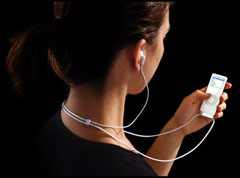Preventing Hearing Damage
Have you ever heard of iPod ear? It's a new phenomenon that will be adding younger people to the disability population. What causes it and how can you prevent it?
In the workplace, we are aware of OSHA standards mandating ear protection, but in our everyday lives we are more at risk for permanently damaging our hearing not only from listening to loud music, but also from using headphones or ear buds that blast the sound into to the inner ears.
Most people are exposed to dangerous noise levels on a daily basis, but usually for far less time that it would take for hearing damage to occur. The harmful effects can be cumulative, so long-term exposure to short periods of loud noise can produce hearing loss years later.
It used to be musicians and concert-goers who failed to use hearing protection subjected themselves to acoustic trauma on a regular basis. Now with the prevalent use of iPods and other types of MP3 players, this ear trauma is happening daily and creating hearing loss in a younger demographic. It isn't just for aging hippies or Deadheads anymore. Generations X and Y are now developing significant hearing loss because of their frequent use of digital music players.
iPod ear hearing loss happens in the inner ear when high energy sound waves, rippling through ear fluid, over stimulate and kill hair cells. Once these inner ear hairs cell are killed, the hearing damage is irreparable. If loud noise only damages the hair cells beyond their capacity to heal completely, then either hearing at certain frequencies will be diminished and/or the listener will develop tinnitus. Tinnitus is typically described as a persistent, loud buzz in the head at the frequency of the hearing damage. Diminished hearing can be corrected to a degree with hearing aids. Tinnitus is currently not curable, but there are treatments and devices to minimize its impact on those who have it.
Another hearing phenomenon that seems to be more noticeable with ear bud use is a decreasing sensitivity to sound levels over time, as the ears adapt to loud sounds. The listener perceives a gradual drop in loudness even though the volume control setting hasn't changed. It is all too easy for iPod users to turn up the volume to the point where hearing is at risk. Therefore, it is important to avoid listening fatigue by resting the ears in silence after long sessions with the ear buds and to fight the temptation to turn up the volume.
SYMPTOMS OF HEARING DAMAGE
The following symptoms are serious enough to need an appointment with the ear doctor:
-
Ringing or buzzing in the ears
-
Difficulty in understanding speech
-
Slight muffling of sounds
-
Difficulty understanding speech in noisy places or places with poor acoustics
Anyone who listens to loud music or is exposed to loud noise on a regular basis should test hearing periodically, because hearing loss can be cumulative, very gradual and virtually symptomless.


